|
|
|
AFTER A TYPHOON, OFF
SWATAU
|
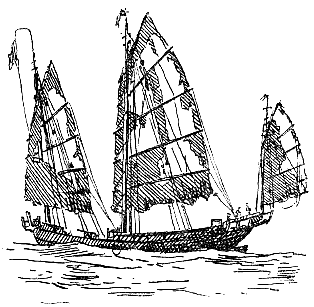 It
would require years of careful observation and study to
give anything like a complete account of the infinite
varieties of craft which arc used by the Chinese to meet
the varying requirements of the vast floating population
dwelling along their widespread coasts and enormous
inland waterways. A few remarks may, however, suffice to
show that the Chinese junk, instead of being, as seems to
be commonly supposed, the most lubberly and cumbersome of
craft, is in reality, like the line-of-battle ship of
Nelson's later years, as perfect in its own way as it can
well be.
It
would require years of careful observation and study to
give anything like a complete account of the infinite
varieties of craft which arc used by the Chinese to meet
the varying requirements of the vast floating population
dwelling along their widespread coasts and enormous
inland waterways. A few remarks may, however, suffice to
show that the Chinese junk, instead of being, as seems to
be commonly supposed, the most lubberly and cumbersome of
craft, is in reality, like the line-of-battle ship of
Nelson's later years, as perfect in its own way as it can
well be.
|
|
|
LEEBOARD BOAT, YANGTZE --
REEFED
|
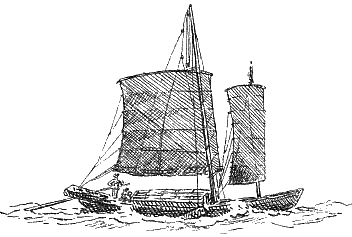 The
observer must not be carried away by the peculiarities of
the superstructures usual in all the larger junks. They
are embellishments which add very greatly to the comfort
of life on board, but in no way affect the under-water
lines of the ship. A little observation will show that
the under-water body of the junk, especially in the
south, is generally very 'sweet,' and by no means far
removed from that of a corvette of eighty years ago. The
frequent absence of keel in the junk is, however, against
good work to windward. The deep rudder, which at sea is
lowered down the trunk by windlasses, and extends well
beneath the ship, and the forefoot or gripe,'which is
often extended under the bows, help considerably to hold
the vessel up to windward. A few hours spent watching the
daily crowd of junks beating through the Lymun Pass out
of Hong Kong harbour during the north-east monsoon, will
persuade the greatest unbeliever that for speed and set
of her sails the junk is not easily beaten; and a finer
sea picture not the Thames in Sea Reach can
show.
The
observer must not be carried away by the peculiarities of
the superstructures usual in all the larger junks. They
are embellishments which add very greatly to the comfort
of life on board, but in no way affect the under-water
lines of the ship. A little observation will show that
the under-water body of the junk, especially in the
south, is generally very 'sweet,' and by no means far
removed from that of a corvette of eighty years ago. The
frequent absence of keel in the junk is, however, against
good work to windward. The deep rudder, which at sea is
lowered down the trunk by windlasses, and extends well
beneath the ship, and the forefoot or gripe,'which is
often extended under the bows, help considerably to hold
the vessel up to windward. A few hours spent watching the
daily crowd of junks beating through the Lymun Pass out
of Hong Kong harbour during the north-east monsoon, will
persuade the greatest unbeliever that for speed and set
of her sails the junk is not easily beaten; and a finer
sea picture not the Thames in Sea Reach can
show.
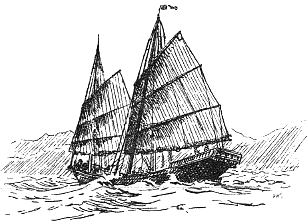 The
Chinese sail is a balance-lug extended and stiffened by
battens, generally of bamboo, with a more or less rounded
leech. It is hoisted on a pole-mast often a very fine
spar, the halyard passing through a large double block on
the yard, and a treble block at the masthead. There is a
hauling parrel to the yard, which keeps it to the mast,
and helps to peak the sail when reefed. Each batten has
its own parrel round the mast, and its own single part
leading to the main sheet. There are various ways of
leading these sheets, one or two of which are here
illustrated, and they constitute the secret of the
flatness of set of the China sail. Double topping-lifts
on both sides of the sail form lazy lines, into which the
sail falls on being lowered for stowing or for reefing.
Reefing is thus simplicity itself; the halyard is let go,
and the weight of the sail and battens brings the sail
down into the topping-lifts; two or more battens are thus
bunched together along the boom, and nothing further is
necessary but to gather in the sheets. There is a
gathering line from the masthead to the boom abreast the
mast.
The
Chinese sail is a balance-lug extended and stiffened by
battens, generally of bamboo, with a more or less rounded
leech. It is hoisted on a pole-mast often a very fine
spar, the halyard passing through a large double block on
the yard, and a treble block at the masthead. There is a
hauling parrel to the yard, which keeps it to the mast,
and helps to peak the sail when reefed. Each batten has
its own parrel round the mast, and its own single part
leading to the main sheet. There are various ways of
leading these sheets, one or two of which are here
illustrated, and they constitute the secret of the
flatness of set of the China sail. Double topping-lifts
on both sides of the sail form lazy lines, into which the
sail falls on being lowered for stowing or for reefing.
Reefing is thus simplicity itself; the halyard is let go,
and the weight of the sail and battens brings the sail
down into the topping-lifts; two or more battens are thus
bunched together along the boom, and nothing further is
necessary but to gather in the sheets. There is a
gathering line from the masthead to the boom abreast the
mast.
|
CHINA LUGSAIL, WITH
SHEET,
TOPPING LIFTS, AND PARRELS
|
|
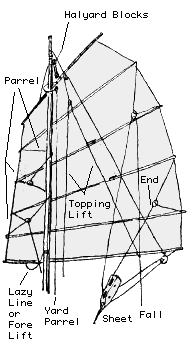
|
BELOW:
SKIFF'S SHEETS
|
|
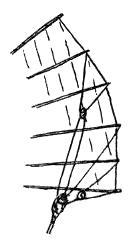
|
The luff of the sail is cut in various
ways. In the big single masted boats of the inland
waterways of the south and the neighbourhood of Canton,
the luff is cut so as to stand out a long way before the
mast as in the case of our Western dipping lugsail, thus
making a true balance-lug, and bringing the centre of
effort farther forward.
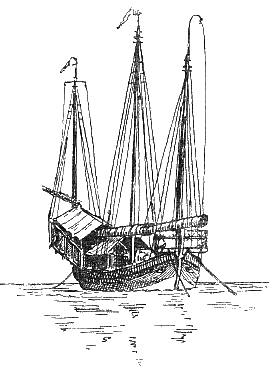
The moment the Chinaman goes to sea,
however, in common with all other blue-water sailors, he
appreciates the advantage of splitting up his sail area
into component parts which are more easily handled, and
are more convenient for bringing a vessel into stays and
paying her off in tacking.
The mainsail is reduced, and then
instead of the modern bowsprit and jib-headed staysails
of the West, he plants a foremast right up in the eyes,
with in most cases a considerable rake forward, reminding
one of the old Mediterranean trinchetto, *1* and sets a
large foresail upon it in the shape of another lug. The
mainsail in this case is cut with its luff straight up
and down the mast, while the foresail is generally so cut
that quite a third of its area, and even more than a
third of its length of boom, is before the
mast. >>Next
Part
*1* The <-> of the log of St. Paul's shipwreck, and
the artemon of the elder Seneca and others, which from
coins of the second, third, and fourth centuries appears
to have been raked over the bows, and to have been
generally adopted for running, wearing, and increasing
the general handiness of the old one-masted
ships.

